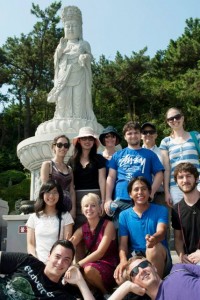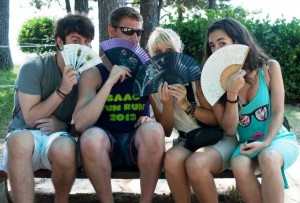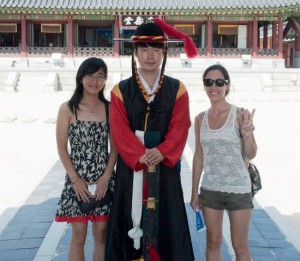After taking a history course focusing on East Asia, James “J.D.” Moore ’14 (Pittsburgh, Pa.) wanted to learn more. He had the perfect opportunity this summer through the faculty-led, short-term study abroad course Interconnections in Northeast Asia, which brought students to South Korea and Japan.

The class in front of a Buddha statue at the Haedong Yonggung temple in Busan, South Korea.
Led by Paul Barclay, associate professor of history and co-chair of the Asian studies program, and Seo-Hyun Park, assistant professor of government and law, the class studied Korean-Japanese interconnections to gain a better understanding of regional patterns and national variations. The group visited Tokyo and Osaka in Japan and Busan, Gyeongju, and Seoul in South Korea to study and compare politics, memory, history, migration, trade, and global culture in both countries.
Moore, a double major in history and film & media studies, decided to add a minor in Asian studies after learning so much about Northeast Asia through the course.
“One of Lafayette’s biggest strengths lies in its opportunities to let students go out and see the world for themselves,” says Moore, who spent a semester in Copenhagen, Denmark, last spring. “My personal background was primarily focused on European history, but after this course, I have found that it is essential to learn as much about as many different cultures as possible.”
A double major in history and economics, Adam Gill ’14 (Wayne, N.J.) traveled to China last summer for the short-term study abroad course China: Ancient Civilization & Global Power and was eager to compare cultures. He also studied in Russia and the Ukraine through the short-term course History, Art, and Culture of Russia and Eastern Europe and in Italy through the Lehigh Valley Association of Independent Colleges.
Studying history where it happened provides real perspective for Gill. For instance, he notes, not only is the Haedong Yong’gungsa temple on the coast of Busan a beautiful structure, it also showcases the various religious influences within South Korea, including Buddhism and shamanism.

Matt Keeler ’14 (left-right), Adam Gill ’14, Katie Weidlein ’16, and Miranda Andretti ’16 pose playfully behind fans at Haeundae Beach in Busan, South Korea.
Understanding history, politics, and culture in context is one of the most critical aspects of studying abroad, says Park. Direct observation helps generate more empathy and interest among students. For example, the group witnessed public demonstrations and expressions of intense nationalism in South Korea as well as the ongoing diplomatic tensions between Tokyo and Seoul. Protesters were marking Korea’s Independence Day, the 68th anniversary of its liberation from Japanese colonial rule.
“A unique aspect of short-term study abroad programs such as ours is that they encourage direct observations, but with a well-defined and shared group purpose,” says Park. “The thematic focus of our course was the history and politics of national identity in East Asia. By visiting a number of museums and important historical sites in both Japan and South Korea, students were able to draw out interesting comparisons through class discussions and informal conversations.”
Sometimes, it was the conversations between Park and Barclay that were the most interesting, says Miranda Andretti ’16 (Bethlehem, Pa.), a double major in English and art. Having two professors who specialize in different areas of Asian history and politics provided dual perspectives on the topics they covered.

Gina Pan ’14 and Miranda Andretti ’16 with a guard at the Suwon Hwaseong Fortress in South Korea
A fan of K-Pop (Korean pop music) since high school, Andretti found Seoul most intriguing. There, the group did an media tour and was part of the studio audience for a K-Pop television show. Even though she had never visited Seoul before, Andretti felt a warm familiarity with the city and enjoyed the cultural exchange with its citizens, who were very interested in where she was from and what she was studying.
“Being abroad was a whole different ballgame as far as my learning experience,” she says. “It brought nuances into the lectures that sitting in a classroom cannot do.”
Barclay agrees that those subtleties have a huge impact on student learning.
“One of our goals in bringing students to Korea and Japan was to help them think about these countries as modern, vibrant, and complex societies,” he says. “Nothing drives these points home as well as frequenting the restaurants, youth hostels, public spaces, and streets of these countries in person. As students traveled from Tokyo to Osaka in Japan, or from Busan to Seoul in South Korea, they also directly experienced the regional diversity within each country and even within each major city that we visited.”


